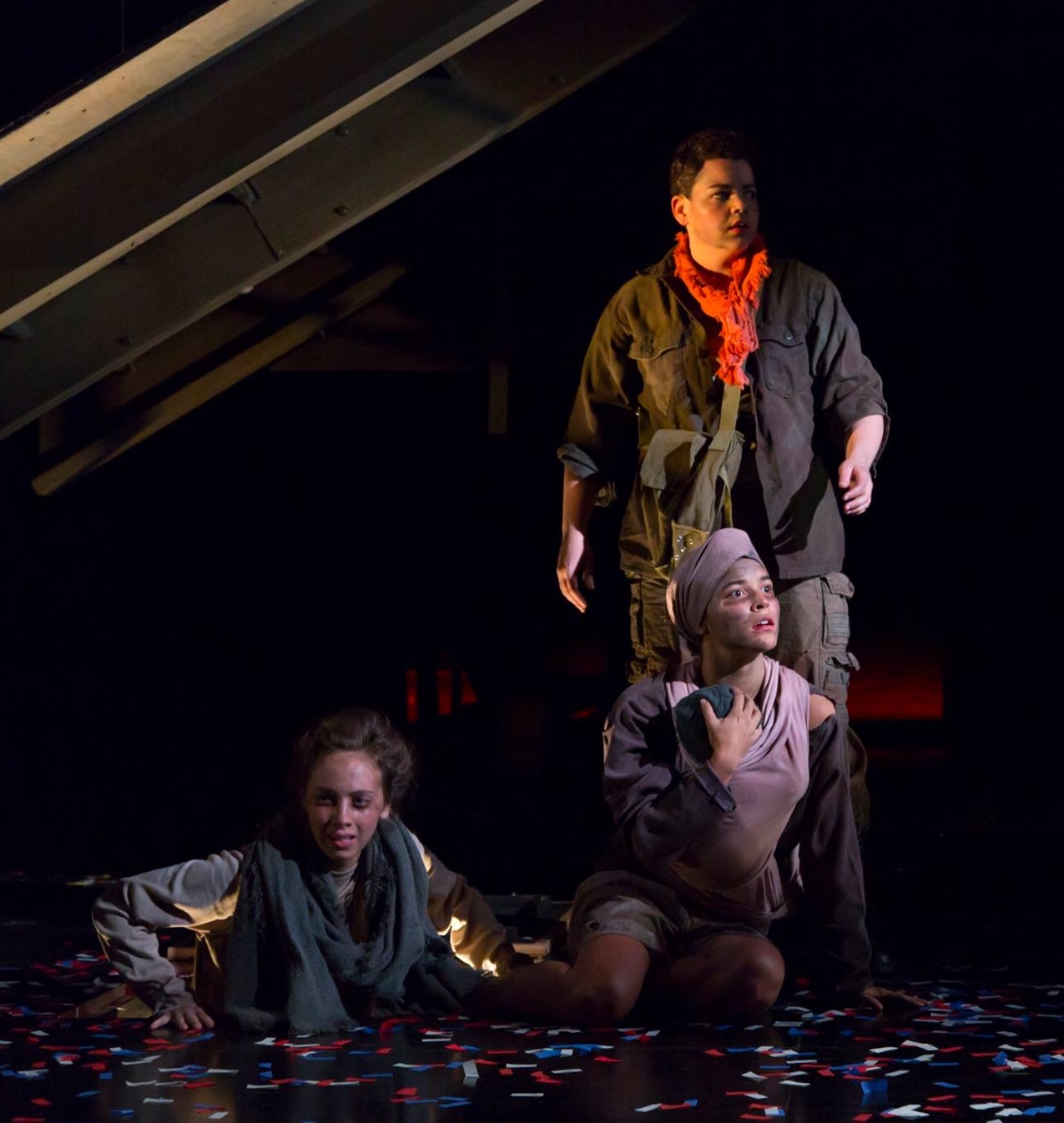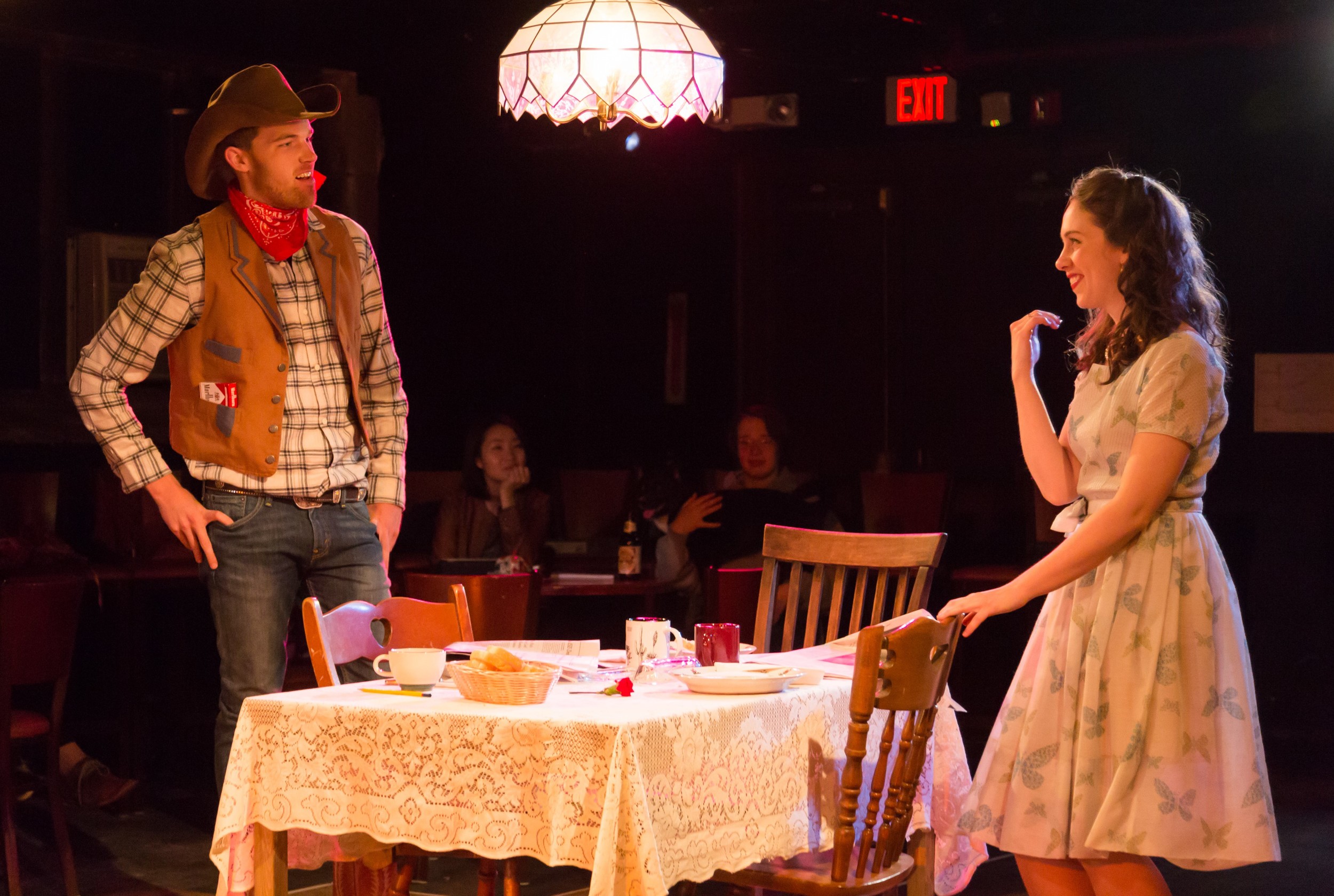Review of The Other World, Yale Cabaret
The Other World, written by Yale School of Drama playwright Charles O’Malley, returns us to the heart of the Aids crisis. A slice of the life of 1980s’ New York artist David Wojnarowicz, adapted from his memoir Close to the Knives, the play dramatizes key events in Wojnarowicz’s artistic life to reanimate the past in episodic scenes presented with a sure hand by first-time director Baize Buzan. Less is more in the spare set, complete with particle-board flooring, a sheet draped casually to serve as a screen for the artist’s overhead projections—a bit of authentic technology that does a Proustian madeleine number on aging memories—and a general feel of the open spaces of those unrenovated SoHo warehouses. In other words, the play is something of a time machine and I, for one, was glad to see a contemporary brought to life so well.
David (José Espinosa) (photo:; Elli Green)
The play’s David (José Espinosa) is an introspective figure whose musings have both great immediacy and fascinating detachment. The loss of David’s lover, the photographer Peter Hujar, to Aids is narrated rather than presented, with further details furnished by Marion (Louisa Jacobson), David’s friend and agent. It’s to the credit of all involved that Peter’s demise comes across with both poignancy and inevitability. Comments on a dying-man’s wish of a visit to the shore lets us intuit the frayed nerves, the sensitive psyches, and, more than anything, the unspeakable specter of death coming to the young and talented. By letting us hear how David copes, O’Malley keeps our focus both on the events and an artist’s access to them. Wojnarowicz, who worked in various media, took pictures and video of his lover’s corpse, an act very much in accord with their shared aesthetic. As David, Espinosa presents a serious artist whose art is very much a confrontation with existence, a battle for personal worth in a damaged world.
Friend (Michael Breslin), David (José Espinosa) (photo: Elli Green)
A visit from a Friend (played with uneasy panache by Michael Breslin) lets us see how out of touch David can be, even while trying to get in touch with his own feelings. The chain-smoking, while a minor detail, speaks volumes for the era these street-based artists inhabit. The Friend’s grasp of his own doomed chances prefigures Wojnarowicz’s fate, but also re-enacts, in miniature, the risky collectivity of gays at the time. The “who can know and who can’t” aspect of their exchange is spot-on. Eventually we see David overcome his morose withdrawal and begin to take steps toward activism, his anger and heartbreak overtaking even his “must-get-away from New York” trip through the Southwest.
David (José Espinosa), Marion (Louisa Jacobson) (photo: Elli Green)
That trip—in a segment called “on the road”—gives the play some of its best scenes, as David breaks out of his silence to confide an early sexual exploit in a movie theater and then to rail at Marion for being a confidante who doesn’t confide enough herself. As played with canny conviction by Louisa Jacobsen, Marion is an interesting character with her own conflicts. Her faith in David, after working with him for five years, is being tried by his state of mourning and his growing interest in the politics of the plague. Their exchanges do much to give us a sense of how they see themselves and each other, and provide a context of youth and exploration that, if not dated, is at least a reminder of how Aids changed so much and cost so many.
Without making heavy-handed parallels with the present, O’Malley’s play reanimates a specific era of repression to remind us of how hard-won rights were and admission to the status quo has been, and to indicate that getting a hearing in government is no easy matter. It’s not that a trip back in time is going to make Trump look better, but it does serve to highlight how shitty conservative governments can be to anyone outside their ideology. Marches and protest might make for good political theater but, as Marion exhorts David, an artist can make larger and perhaps more telling statements. And so is born an artist-activist, aghast at the horrors made normative by American indifference.
Born 100 years after his sometime artistic alter-ego Arthur Rimbaud, Wojnarowicz, like Rimbaud, died at 37. Both continue to live on because both have something to say to the “accursed” on the outside or margins of the mainstream. If “silence = death,” one of the slogans of Aids activism popularized by ACT UP, it’s also the case that death, for visionary artists like Wojnarowicz, doesn’t equal silence.
David (José Espinosa) (photo: Elli Green)
The Other World
By Charles O’Malley
Adapted from Close to the Knives: A Memoir of Disintegration by David Wojnarowicz
Directed by Baize Buzan
Production Dramaturg: Kari Olmon; Scenic Designer: Paul Rasmussen; Costume Designer: Sophia Choi; Lighting Designer: Krista Smith; Sound Designer: Andrew Rovner; Projections Designers: Yana Birÿkova, Michael Commendatore; Scenic Advisor: Ashley Flowers; Stage Manager: Cate Worthington; Producer: Caitlin Crombleholme
Cast: Michael Breslin, José Espinosa, Louisa Jacobson
Yale Cabaret
April 6-8, 2017
























